![]()
![]()
![]()
Use LEFT and RIGHT arrow keys to navigate between flashcards;
Use UP and DOWN arrow keys to flip the card;
H to show hint;
A reads text to speech;
40 Cards in this Set
- Front
- Back
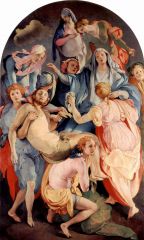
|
Pontormo
The Entombment or Deposition of Christ (1525-1528) Florence |
|
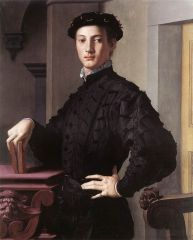
|
Bronzino
Portrait of a Young Man (c. 1530-1545) Florence Performance; Mask |
|
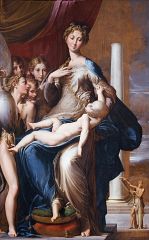
|
Parmigianino
Madonna with the long Neck (1534-1540) Parma column refers to the Virgin Mary |
|
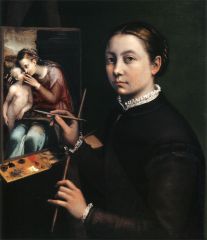
|
Sofonisba Anguissola
Self-Portrait (c.1556) |
|
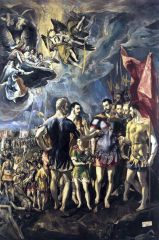
|
El Greco
Martyrdom of Saint Maurice and the Theban Legion (1580-82) For the Escorial Rejected by Philip II for its lack of Decorum, wasn’t considered appropriate for Counter-Reformation ideals - No clarity of message, martyrdom is represented in the corner, not dignified. |
|
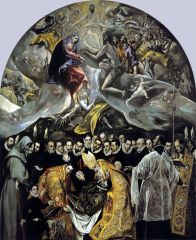
|
El Greco
Burial of the Count of Orgaz, 1586-88 for church in Toledo more in tune with Counter-Reformation ideals: Represents the apparition of St. Augustine and St. Stephen during the burial of a 14th century Toledan nobleman; Emphasizes Catholic view on Good works as essential for salvation |
|

|
Annibale Carracci
Loves of the Gods (1597-1601) Farnese Gallery, Rome Commissioned by Cardinal Farnese; Possibly commemorates marriage of Cardinal’s brother; decorates a room that was used as an art gallery: Quadro Riportato: simulated easel paintings; Illusionism: Awe, Wonder |
|
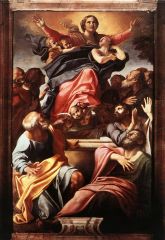
|
Annibale Carracci
Assumption of the Virgin (1601) Private chapel in church in Rome compare to Caravaggio, Crucifixion of St. Peter, in the same chapel (Rome, c. 1601) |
|
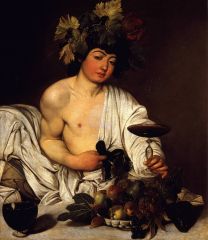
|
Caravaggio
Bacchus (1597-98) |
|
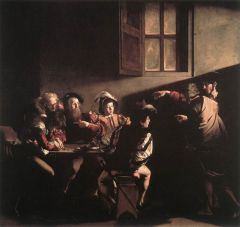
|
Caravaggio
Calling of St. Matthew (c. 1597-1601) Private chapel in church in Rome Including individuals with contemporary dress - makes the painting more approachable. |
|

|
Caravaggio
Crucifixion of St. Peter (c. 1601) Private chapel in church in Rome Compare to Annibale Carracci, Assumption of the Virgin, in the same chapel, (Rome c. 1601). |
|
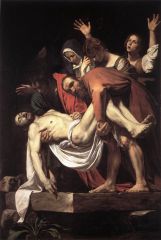
|
Caravaggio
Entombment (c. 1603) Private chapel in church in Rome Transubstantiation: the transformation of the Eucharistic bread and wine into the body and blood of Christ |
|
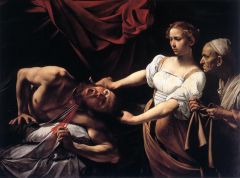
|
Caravaggio
Judith Beheading Holofernes (c. 1599) exemplifies the limitations of a method based on copying from the model only. |
|
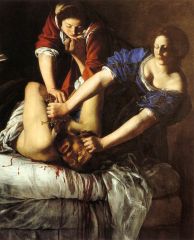
|
Artemisia Gentileschi
Judith Slaying Holofernes (ca. 1614–1620) Compare to Caravaggio, Judith Beheading Holofernes (c. 1599) She challenges the limitations of Caravaggio's method of coppying only from the model |
|
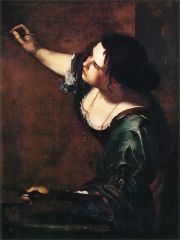
|
Artemisia Gentileschi
Self-Portrait as the Allegory of Painting (1630) Pittura (Ripa’s Iconologia); compare to: Dürer, Self-Portrait (1500); Titian, Self-Portrait (16th cent); Rubens, Self-Portrait (1638-40) Representing in the act of painting, which is very rare. |
|

|
Bernini
Apollo and Daphne (1622-4) Galleria Borghese, Rome Was displayed in a room used as art gallery; showpiece for Bernini; theme from Ovid’s Methamorphoses; Awe, Surprise, Wonder |
|
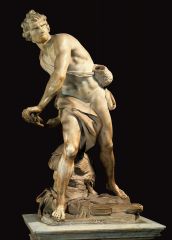
|
Bernini
David (1623-4) Galleria Borghese, Rome Compare to Michelangelo, David (1501-1504); Donatello, David (c. 1440-1460) |
|
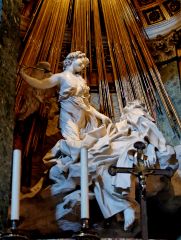
|
Bernini
Ecstasi of Saint Teresa (1645-52) (Chapel in church in Rome Represents Saint Teresa of Avila, a Spanish mystic known for her visions and trances who had just become saint in 1622: Great example of Baroque’s interest in psychology, the representation of extreme feelings, and the sense of infinite through light; theatrical elements; Bel composto - different elements of art in one work (use of sculpture, painting, and architecture, also light) |
|
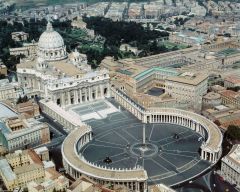
|
Bernini
Saint Peter’s Piazza (1656-1667) Urban VIII: Combines the Greek cross plan of the Renaissance church with the early Christian Basilica (need to accommodate more people and archeological interest in the early church); Saint Peter’s represented the symbolic seat of the Papacy, so it had to be spectacular; Bernini created four rows of huge columns (colonnades) that have the effect of embracing all who enter the piazza, symbolizing the welcome the Roman Catholic Church gave its members during the Counter-Reformation. |
|
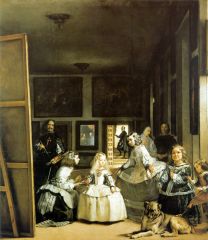
|
Velázquez
Las Meninas or The Maids of Honor (1656) Self-portrait; portrait of the princess Margarita; portraits of Philip IV and his wife (reflected in a mirror); Cross of Santiago (military order). Showing his pride, in being in the presense of the Royal Family |
|
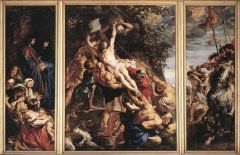
|
Rubens
The Raising of the Cross (1610-11) Antwerp, Flanders/Belgium Triptych; life model; ancient sculptures (Laocoon); created after oil sketch |
|
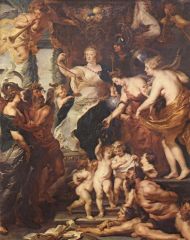
|
The Marie de’ Medici Cycle (c.1621-1625)
Paris, France |
|
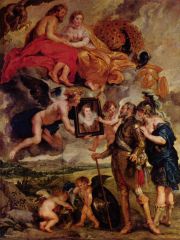
|
Rubens
The Presentation of Marie de’ Medici’s Portrait to Henri IV (1622-25) Henry IV; Zeus; Juno; France |
|
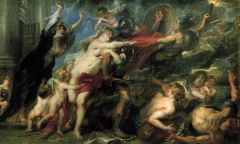
|
Peter Paul Rubens
Allegory of War (1638) |
|
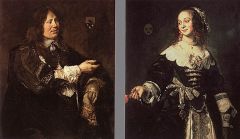
|
Frans Hals
Pendant Portraits of Married Couple (Stephanus Geraerdts and Isabella Coymaus) (1650-52) Pendants (meant to be displayed next to each other), follows some of the typical conventions of portraiture: pale woman (inside the home); darker-skinned man (works outside); woman at the left of the man (lesser side). Also offers some innovations (more informal; intimacy between the couple; Calvinist ideas of marriage for love; lose brushwork) |
|
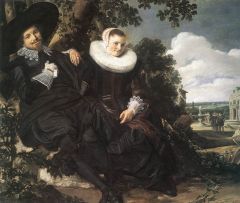
|
Frans Hals
Double Marriage Portrait (of Isaac Massa and Beatrix van der Laen) (c. 1622) Double portrait: even more intimate; informal poses; Calvinist ideas of marriage for love; landscape setting; lose brushwork) |
|
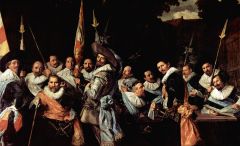
|
Frans Hals
Archers of Saint Hadrian (c. 1633) Militia Company (only symbolic function at this point): enlivens the tradition of group portraiture through variety of postures and brushwork: accomplishes function of presenting the unity of the group and each of its members simultaneously. |
|
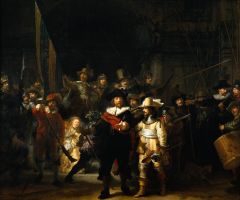
|
Rembrandt
The Night Watch (1642) Civic-Guard (Militia Company); commissioned around for the banquet room of Amsterdam’s new Musketeers Hall; Captain Frans Banning Cocq: Conventions of History painting; portraits subordinated to main action: a parade; theme of fire arms relates to this group’s right to carry fire arms. |
|

|
Rembrandt
Self-Portrait with Gold Chain (1633) Gold chain refers to the admiration bestowed by kings and nobles; self-portrait becomes a kind of performance; interest in the expression of the passions of the soul |
|

|
Rembrandt
Return of the Prodigal Son (c. 1665) Religious work for protestant audience; psychology; light creates a mood; rough painting. |
|
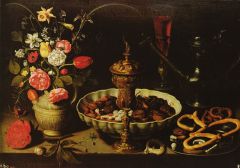
|
Clara Peeters
Still Life with Flowers, Goblet, Dried Fruit, and Pretzels (1611) Self-reflection in goblet works as a kind of signature and reveals pride in her profession as the ultimate craftsman (skill at representing different media); it also establishes connection with the Northern tradition (Van Eyck’s self-reflections); tulips (expensive, imported) |
|
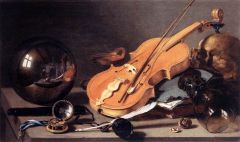
|
Pieter Claesz
Vanitas Still Life (1630s) Example of “vanitas still life:” where the representation of material possessions is tamed by objects that remind us of the vanity of worldly goods (following Calvinist believes); References to mortality and the passing of time; Self-portrait of the artist appears as reflection. |
|
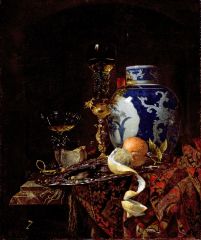
|
Willem Kalf
Still Life with Chinese Jar (1669) Trade and economy are suggested here through some of the objects; reflects prosperity of the Dutch after independence; the presence of the watch also reflects vanitas ideas - the passing of time: material wealth isn't important when compared with the scale of time. |
|
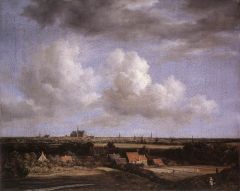
|
Jacob van Ruisdael
View of Haarlem (c. 1670) Landmarks (Church, windmill); Harmony between Town and Country, Rural and Urban; Nationalistic Pride: The Dutch, contrary to much of Europe, actually own their own land. Produced for the Art Market. A painter usually specialized in one genre. |
|

|
Vermeer
View of Delft (c. 1661) Cityscape; camera obscura |
|
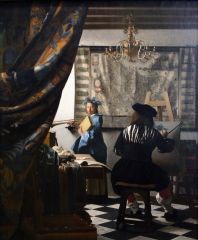
|
Vermeer
The Art of Painting (c.1666-7) The attributes of this woman are those of Clio, the muse of history; laurel crown; trumpet; book; map on the wall; interest in women as subject (Saint Luke painting the Virgin); skill at representing different media. |
|
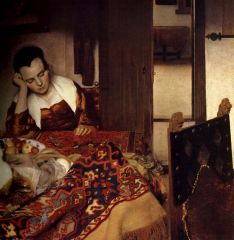
|
Vermeer
A Maid Asleep (1656-57) Maid was entertaining a male guest, had too much to dring, and fell asleep. At the time, maids were seen as lazy and loose. |
|
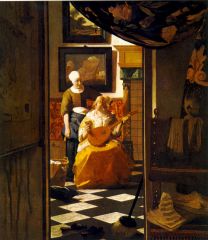
|
Vermeer
The Letter (1666) |
|
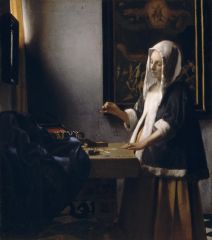
|
Vermeer
Woman Holding a Balance (1662-64) Last Judgment; Introspection; Material vs. Spiritual |
|

|
Jan Steen
In Luxury, Look Out (1663) Dissolute Household; World Upside Down; Comic Painting. |

